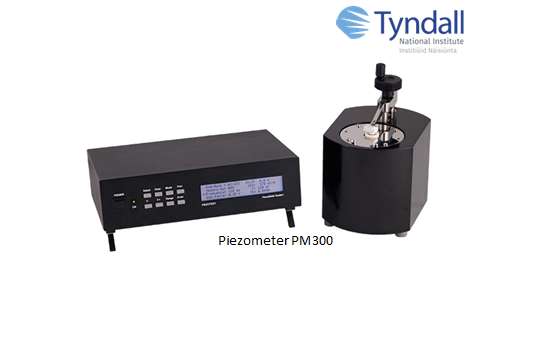Equipment offering: Piezoelectric coefficient d33 measurement
About
d33 indicates charge per unit force in the polarisation direction a piezoelectric sample. In Tyndall National Institute, we have created a unique facility to measure the d33 coefficient for Bulk and thin-film piezoelectric samples using a tool called Piezometer PM300.
Description
The extraction of the piezoelectric coefficient d33 from bulk and thin-film piezoelectric materials is a crucial process in the field of materials science and engineering, particularly in the development and application of piezoelectric devices. The Piezometer PM300 emerges as an essential tool in this context, offering a comprehensive solution for assessing the piezoelectric properties of materials. Apart from d33, it is also possible to measure the capacitance between the two electrodes and the dielectric loss factor tanδ of the sample under measurement.
The piezoelectric coefficient d33 represents the material’s ability to convert mechanical energy into electrical energy and vice versa. It is a fundamental parameter that determines the efficiency and sensitivity of piezoelectric devices, such as sensors, actuators, and transducers. Accurate measurement of d33 is vital for:
Design and Optimization: Understanding the piezoelectric properties enables the design of more efficient and tailored devices for specific applications.
Material Selection: Identifying materials with optimal d33 values facilitates the selection process for various engineering applications.
Performance Evaluation: Assessing the d33 coefficient helps in evaluating the performance and reliability of piezoelectric devices over their operational life.
In manufacturing and production lines, the d33 measurement ensures that the piezoelectric materials meet the required specifications, maintaining high quality in the final products. For researchers, the capability opens the possibilities for exploring new materials and optimizing existing ones, pushing the boundaries of piezoelectric device performance. By enabling detailed analysis and testing of piezoelectric properties, the measurement contributes to the development of innovative applications, from energy harvesting devices to precision actuators in medical devices.
Technical specifications:
Sample size: minimum 1.5 cm x 1 cm
Maximum 50 mm in polarisation direction and 68 mm perpendicular (i.e. maximum diameter of a symmetrically supported disc is 136 mm).
Electrode requirements: Two electrodes – one at the top of the sample and the other at the bottom of the sample. Minimum diameter of the metal electrodes is 1 mm.
The static load applied on the sample is 10 N to grip the sample properly between the two metal clamps. The typical frequency of measurement is 110 Hz with a dynamic load of 0.25N. But the measurement frequency can be adjusted within the range of 30 Hz to 300 Hz.
Dynamic measurement range for d33: 0 to 10000 pC/N with an accuracy of ±2%
Access Provider / Facilities




